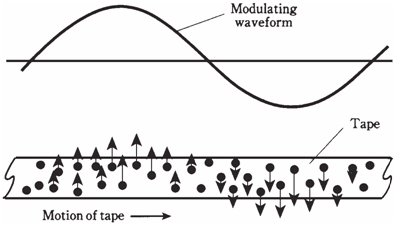Audio tape
The initial computers used audio tape to store data. Printed matter was recorded on tape by using audio frequency shift keying (AFSK). This can be done, but disks are often used in modern computers, personal computers. Nowadays, tape is used for storing voice, music.
The audio tapes are available in reel-to-reel or cassette form. You have used them for recording voices and music, or at least for enjoying your favorite musical talent.
Recently, compact disks (CDs) have begun to displace magnetic tape for recording of speech and music.Magnetic tape has millions of iron-oxide or ferromagnetic particles. In recording process, a signal is applied to coils in recording head. The recording head is electromagnet. It polarizes the particles on tape as the tape moves by. The particles hold small magnetic fields till they are changed by rerecording. When tape is played back, the movement of magnetic fields past the pickup head generates a fluctuating current in a small coil; this current replicates original recorded signal.

Figure--In a magnetic tape, particles are polarized by modulating waveform.
Characteristic speeds for the audio tape are from about one inch per second for dictation microcassettes, to 3.75 or 7.5 ips for the reel to reel hi-fi tapes, to 15 ips for marketable hi-fi audio tapes.There are at least 4 tracks on an audio tape, giving a left and right channel for each direction of movement. Some of the tapes have 8, 16, or 24 tracks. The tracks run parallel to length of tape.
Typical tape widths are 1/8 or 1/4 inch for the consumer use, although in the commercial and military applications, wider tape is used often. The thickness varies, being specified in mils, where 1 mil = 0.001 inch. Characteristic thicknesses are 0.5 mil, 1.0 mil, or 1.5 mils. The thinner a tape, longer it will run for a given cassette or reel size. But thicker tapes have less tendency to stretch.